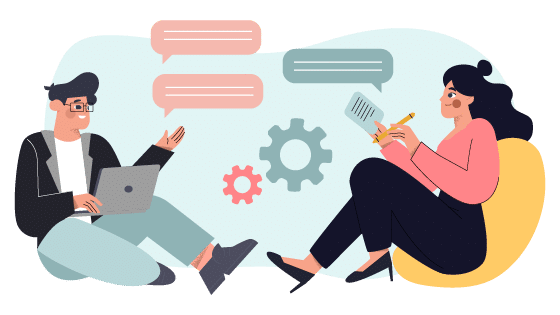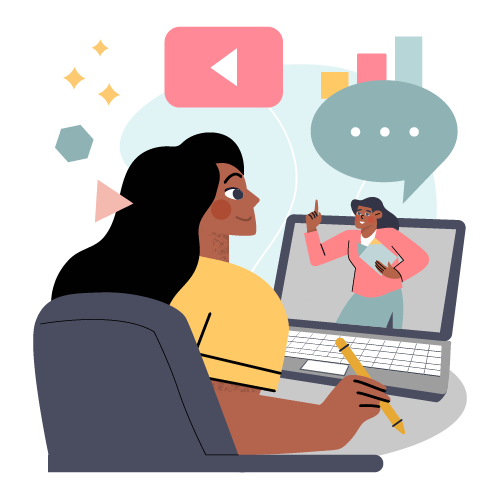You might associate it with reaction videos and makeup tutorials, but YouTube is actually a great teacher too. Think about all the times you’ve turned to video to help you learn to do something—from fixing your washing machine to perfecting your contour.
It makes sense too: A 2021 study by Squarespace found that 59 percent of Gen Z-ers and 55 percent of millennials have a clear preference for video over in-person learning, apps, games, or even books, giving video a clear advantage in the age groups making up most of the modern workforce today.
When two generations are brought up on video (one of the most efficient and convenient ways to spread information), they’re bound to prefer it over other methods. You might already have a video library in place as part of your training strategy.
But have you considered the impact of videos on your mobile learning strategy?
If you combine the benefits of video learning (accuracy, engagement, shareability) with the best parts of mLearning (quick, accessible, reviewable), you have the makings of a training strategy that gives learners exactly what they want. While you might feel like you’re in a battle of the generations when creating eLearning experiences, videos and mobile learning are the perfect match for the learning process.
What is video-based mobile learning?
Video-based mobile learning is video content that is optimized for mobile delivery methods. Chances are that the last time you watched a video, you did so on your mobile device. It’s quick, convenient, and already in your pocket.
Those three factors are what make video-based mobile learning so unique when compared to traditional training methods. By making online training hyper-accessible, you increase the chances that learners are actually going to watch, engage with, and retain the content you share.
The role of video in mobile learning experiences
There are plenty of ways to deliver content to a mobile device. Sometimes, it’s via text or group messaging, which can vary in format such as SMS or MMS, each offering different multimedia capabilities for engaging learners more effectively. Mobile learning could be something as simple as flashcards or something as in-depth as a custom app. Video is simply a content category uniquely poised to leverage your learners’ existing tools while maximizing the benefits of visual learning.
How is video-based learning different?
Video usually falls into one of three categories:
- Live action. Live action videos are where an instructor presents information or actors act out a scenario. This is the closest to traditional in-person learning methods and, when delivering to a mobile device, videos are simply uploaded to a service like YouTube or Vimeo, and learners view them via a link.
- Animation. When characters or avatars depict scenarios or demonstrate procedures, it’s categorized as animation. Animation is usually engaging and a common part of using mobile devices. Games, learning apps, and even utilities on mobile phones rely on animation to direct users and keep them glued to their screens. Animated videos harness that engagement and familiarity to make mobile learning a more engaging and connective experience.
- Simulation. When you need to show a complicated process, simulation videos are your best bet. That’s because video allows users to slow down, go back, or pause along their learning path to examine processes more carefully. Simulations also show cause and effect in a safe space, which means users can test their skills and get instant feedback to adjust as necessary.
The benefits of video in mobile learning
We know that learners love video and they love mobile learning, but what makes them the perfect match for the learning process? Adding video to mobile learning or making videos compatible for mobile devices has a few specific benefits that are too big to miss. It’s a bit of a chicken-and-egg scenario: Do videos make for better mobile learning, or does mobile learning make video content super accessible?
Cost
Sure, it would be easier if learners were always in the same place at the same time to learn together. Of course, it’s not a perfect world: your organization might have any number of branches, and in-person training can be wildly expensive. Delivering videos straight to learners’ mobile devices cuts down on online training costs because the same training can be deployed anytime, anywhere.
Autonomy
Utilizing videos for mobile learning allows learners to control their own learning path: they can fast forward through information they already know, rewind to go over concepts they’re having trouble grasping, and review information anytime and anywhere. Handing that control over to your learners might seem like a risk at first, but here’s the thing: They’re going to be on their phones anyway. Why not leverage that for more engaging learning experiences?
Accessibility
The modern workplace is a rich tapestry made up of a spectrum of generations, and those generational gaps can cause real problems in training. How can administrators offer content that works across a generationally divided workplace? Try bridging the gap with mobile learning because no matter the age, most employees have access to smartphones and websites like YouTube and Vimeo and can use the apps in ways that help them customize their learning experience based on their levels of ability. Even something as simple as being able to increase screen contrast or adjust subtitles can make a huge difference in the learning process.
Retention and reinforcement
The general rule is that the more senses you engage while learning, the more likely your brain is to sort information into long-term memory. When you hear something, you’re only activating one sense. If you hear, see, and touch via interactive video, your brain is highly engaged, creating stronger neural pathways to retain and retrieve that information later. The reinforcement piece comes into play with the accessible, just-in-time nature of video paired with mobile learning. Learners can access information in the moment, refresh their memories, or even repeat entire videos to keep those neural pathways strong.
Conclusion
A small screen might mean the next big thing for your video content. When it comes to creating your next online training program, video is the perfect match for a mobile delivery system. The workplace is ever-changing and whether it’s new tech, new ideologies, or a literal worldwide pandemic, it wouldn’t be overdramatic to assume that video will be a component to almost all mobile learning strategies in the future. Millennials, Gen Z, even Generation Alpha—no matter the age, taking your learners to the next level will require more engagement, better accessibility, and the perfect combination of mediums.
Ready to update your online training to a mobile-first strategy? Drop us a line and let’s get started.






